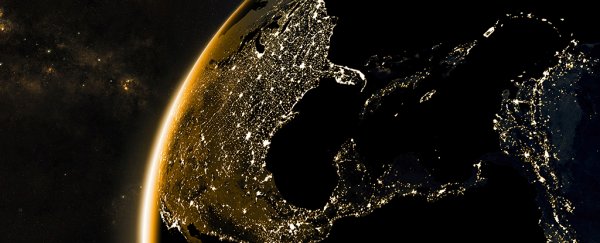The immense popularity of the bright, energy-saving electrical components called light-emitting diodes (LEDs) has been a boon for the environment. But researchers are also discovering it has come at a rather serious cost.
Thanks partially to solid-state lighting's bigger bang for your buck, the growing problem of light pollution is showing no sign of slowing, which is bad news for our ecosystems and our health.
A big part of the problem is we just don't think of light in the same way we do noxious aerosols or toxic fluids.
So when we invent new light-emitting technology, we're less likely to think of the potential cost to the environment – we think of what annoying shadows we can blast away with a few extra bulbs.
The result is as clear as daylight – our world has less darkness than ever before.
Physicist Chris Kyba from the German Research Centre for Geosciences has led a study using satellite data to investigate how brighter our nights are becoming.
And while he doesn't point the finger solely at LEDs, they do represent the problem.
"We'll light something that we didn't light before, like a bicycle path through a park or a section of highway leading outside of town that in the past wasn't lit," says Kyba.
The researchers use the term 'rebound effect' to describe how a savings in energy leaves us with more money that we simply pour back into the product.
We can see the same effect in our approach to buying cars – better fuel efficiency leads to more fuel to drive longer distances, rather than a reduction in overall power consumption.
Light pollution isn't a new concern, especially among astronomers, ecologists, and insomniacs.
Outdoor illumination grew at a rate of about 3 to 6 percent per year in the second half of the 20th century, seeing an end to night as we knew it in many parts of the world. And we've needed to rely on statistical estimates and assumptions to get a grip on how bad it is.
Sufficiently calibrated satellite technology has only recently provided data that's accurate and reliable enough to monitor the problem in detail.
The team used information gathered by a radiometer called the Visible/Infrared Imager Radiometer Suite (VIIRS), which was mounted on a National Oceanic and Atmospheric Administration (NOAA) satellite named Suomi NPP.
Restricting themselves to data collected in October in order to avoid added illumination from holiday period festivities, the researchers analysed the growth in light pollution between 2012 and 2016.
On average the amount of area illuminated at night increased by about 2.2 percent each year. Continuously lit areas were also about 2.2 percent brighter each year.
Growth mostly occurred throughout South America, Africa, and Asia, while declines in lighting were noticed mostly in war-torn zones, such as Syria and Yemen. Illumination had stabilised in just a few countries, mostly those which were already brilliantly lit.
If this all sounds serious, the reality is likely to be slightly worse. The satellite data couldn't directly detect the bluer wavelengths emitted by many LEDs.
"We can say with fairly high confidence even though we didn't measure in the satellite an increase in these countries, they are nearly certainly increasing in brightness in terms of how human beings would perceive the light," says Kyba.
This end of the visible light spectrum more closely resembles daylight, so even if we were to assume the overall luminosity didn't increase in countries that were replacing old bulbs with LED technology, we'd still perceive night to feel more like day.
It's well established that this flood of blue light has a serious impact on our health and wellbeing.
It also messes with wildlife – you might not care much about a few moths getting dazed by the lights, but research shows LED lighting could have profound impacts on a range of plant and animal species.
Manipulating their spectrum and intensity according to certain times of the day could offer a small amount of respite, but there's a lot to be said for simply asking if we really need so much light.
By 2020, LED lights are set to account for 61 percent of the global lighting market. That's a good thing where power consumption is concerned.
It should also be a reminder to remember there's another kind of pollution we need to be concerned about when it comes to switching off that light.
This research was published in Science Advances.
